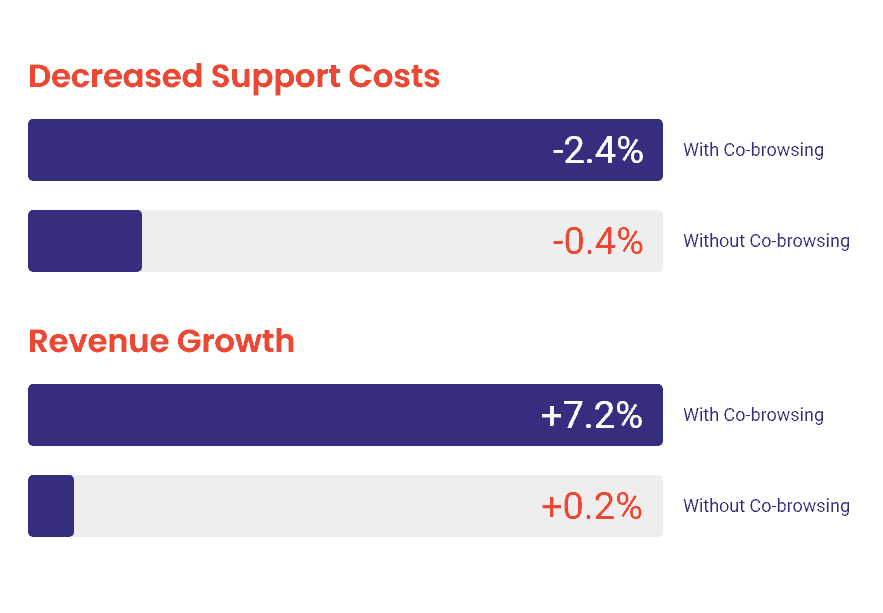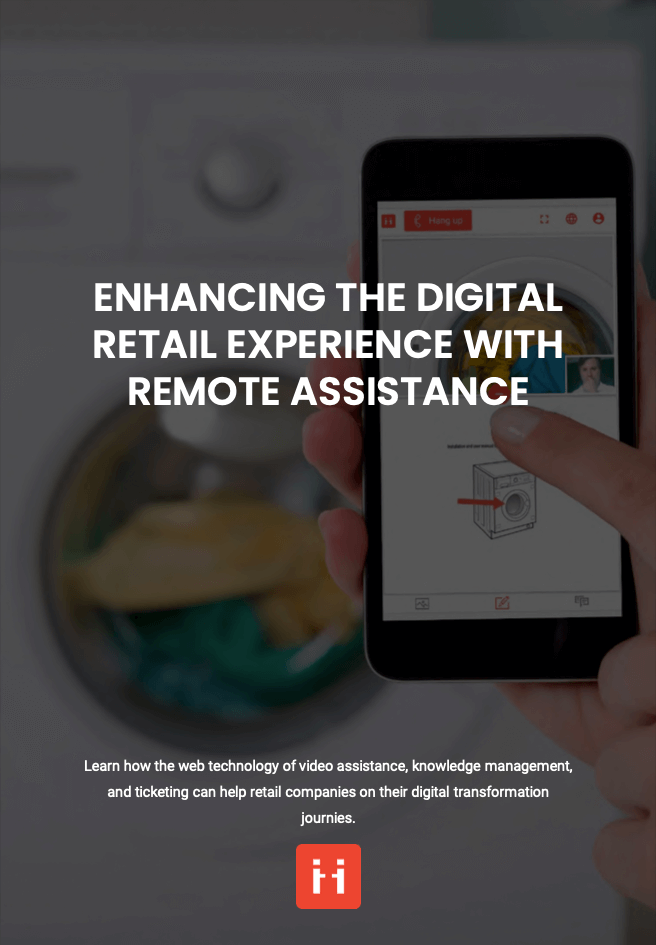
Share this article
Share this article
Often being seen as more important than the price of the product, customer experience reigns supreme. By creating a personalized support experience, co-browsing dramatically increases consumer satisfaction. Additionally, co-browsing helps streamline KPIs thus decreasing costs.
Co-browsing is a virtual engagement customer support tool for contact centers and sales teams. It innovates simple screen sharing by enabling simultaneous web page browsing by two or more users.
Co-browsing becomes a powerful customer support tool that boosts performance metrics significantly when coupled with omnichannel tools such as video assistance.
Co-browsing software is safe. Safety is a key metric when considering customer satisfaction. This software is strictly hosted within the browser making it highly secure. Additionally, WebRTC co-browsing has data-masking features that shield with HTML. This means that agents can neither see nor interact with specific elements of a webpage, like a credit card field or anything else personal.
Above all else, co-browsing is a means for companies to distinguish themselves from competitors. Going forward, themes such as empathy are key to operating a successful customer service operation. 89% of companies compete on the quality of customer service alone, therefore themes like empathy become clear differentiators. Co-browsing also gives companies a competitive edge by giving them a way to engage more profoundly with their customers and demonstrate higher levels of empathy.
Incorporating co-browsing into your business functions will add value to your organization in five key ways.
Adolescebat autem obstinatum propositum erga haec et similia multa scrutanda, stimulos admovente regina, quae abrupte mariti fortunas trudebat in exitium praeceps, cum eum potius lenitate feminea ad veritatis humanitatisque viam reducere utilia suadendo deberet, ut in Gordianorum actibus factitasse Maximini truculenti illius imperatoris rettulimus coniugem.
Quality of experience, more so than price, is the key metric that customers use when choosing products. In fact, 86% of buyers are willing to pay more for great customer experience. Modern technology trends like co-browsing are quickly being adopted by companies to distinguish themselves from competitors. Co-browsing provides exactly what customers want; rapid, frictionless problem resolution.
Co-browsing lessens customers’ efforts: At the point of contact with the customer, the agent is able to quickly ascertain the problem and then take control of the customer’s screen. Co-browsing allows the agent to customize his or her service to fit the customer’s issues. Whether it be demonstrating how to navigate a website or aiding in the checkout process. Visual engagement solutions minimize customer effort which boosts customer satisfaction.
Companies using co-browsing see annual improvement of 5.1% in their customer satisfaction score. Those without tend to see an annual increase in satisfaction score of around 1.4%. Aside from boosting customer satisfaction, a co-browsing intervention helps familiarize a customer with the website resulting in more repeat visits.
These solutions are easy to use: Co-browsing is supported by WebRTC and operates browser-to-browser. This means that there aren’t any barriers to use such as required downloads or plugins.
Co-browsing ensures rapid problem resolution: We’ve all experienced spending way too much time searching for a specific item or tab on a website. Such an experience is tedious and ultimately sours the browsing experience. Whether it’s a support agent intervening or a customer requesting co-browsing support, a fifteen-second demonstration by a support agent can replace thirty minutes of fruitless searching by a customer.
When describing co-browsing, the key adjective is seamless. Demand for the rapid problem resolution offered by co-browsing is sky high, with 77% of customers believing it takes too long to reach a live agent. If you think you’re fulfilling your customers’ expectations, chances are you need to try harder.
Co-browsing demonstrates that you’re willing to go the extra mile for your customers: This one-on-one assistance offers personalized customer support and places an emphasis on delivering the most seamless visual experience for the customer.
Omnichannel experiences are the future. A recent PwC report found that the number of companies investing in omnichannel support has jumped from 20% to 80%. Importantly, omnichannel support can be leveraged to maximize the impact of co-browsing. Integrating co-browsing into an omnichannel platform helps companies outperform competitors. According to research by Aberdeen Group, companies with the strongest omnichannel customer engagement strategies retain more customers — an average of 89% of their customers, compared with 33% for companies with weak omnichannel strategies.
Functionally speaking, the integration of omnichannel support into co-browsing takes customer support to the next level by allowing agents to solve all customers issues on a single platform. These solutions present themselves in three main forms.
By employing these three solutions, companies greatly increase their agility and ensure that, regardless of the customer’s problem or situation, there is a convenient resolution method.
When it comes to keeping customers engaged on a webpage, co-browsing is in a league of its own. Co-browsing, by guiding customers through the purchase process, helps maximize conversion rates. But how exactly can you optimize conversion rates, and how does co-browsing improve them?
Visual engagement technology like co-browsing empowers support agents to surpass expectations in aiding customers and unlocks their productivity. When using co-browsing there is a 10% greater agent utilization rate compared to those without. Co-browsing empowers support agents in the following ways to optimize customer experience:

Co-browsing has important implications for optimizing the sales cycle.
Securing leads:
The beginning of the sales cycles is often the most challenging. It’s easy for customers to switch from your website to another due to inconvenience or a lack of interest. With co-browsing, support agents can:
Product presentation:
When it comes to sales, seeing is believing. Co-browsing enhances an agent’s ability to communicate a product. With co-browsing, a more detailed product explanation is made possible by the agent’s ability to lead more in-depth product demonstrations in real-time.
A real-time connection with the customer, via co-browsing, allows the sales agent to determine the intended use of the technology. By determining the intended use, the sales agent can then tailor the product presentation to highlight the customer’s ultimate goals.
Customers often face challenges configuring a product due to a lack of expertise. Companies often look to support customers by creating videos or literature explaining a product, however, these tend to leave informational gaps. With co-browsing, each nuance, regardless of how small, can be explained to the customer through a real-time demonstration. This creates a more tech-fluent customer who will likely come back less frequently for repeat aid, easing the burden on tech support teams.
Co-browsing helps widen companies’ profit margins thanks to reduced customer support costs, specifically:

A recent Aberdeen Group study found that businesses employing visual engagement tools like co-browsing enjoy an 83% greater year-over-year increase in annual company revenue compared to others (8.8% vs. 4.8%).

Free E-book available now!